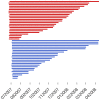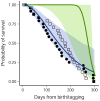Pup mortality in a rapidly declining harbour seal (Phoca vitulina) population
- PMID: 24312239
- PMCID: PMC3842331
- DOI: 10.1371/journal.pone.0080727
Pup mortality in a rapidly declining harbour seal (Phoca vitulina) population
Abstract
The harbour seal population in Orkney, off the north coast of Scotland, has reduced by 65% between 2001 and 2010. The cause(s) of this decline are unknown but must affect the demographic parameters of the population. Here, satellite telemetry data were used to test the hypothesis that increased pup mortality could be a primary driver of the decline in Orkney. Pup mortality and tag failure parameters were estimated from the duration of operation of satellite tags deployed on harbour seal pups from the Orkney population (n = 24) and from another population on the west coast of Scotland (n = 24) where abundance was stable. Survival probabilities from both populations were best represented by a common gamma distribution and were not different from one another, suggesting that increased pup mortality is unlikely to be the primary agent in the Orkney population decline. The estimated probability of surviving to 6 months was 0.390 (95% CI 0.297 - 0.648) and tag failure was represented by a Gaussian distribution, with estimated mean 270 (95% CI = 198 - 288) and s.d. 21 (95% CI = 1 - 66) days. These results suggest that adult survival is the most likely proximate cause of the decline. They also demonstrate a novel technique for attaining age-specific mortality rates from telemetry data.
Conflict of interest statement
Figures




Similar articles
-
On the ecology of the harbour seal Phoca vitulina in the Wadden Sea: population dynamics, residue levels, and management.Vet Q. 1982 Jan;4(1):36-42. doi: 10.1080/01652176.1982.9693836. Vet Q. 1982. PMID: 15861586 Review.
-
State-space modelling reveals proximate causes of harbour seal population declines.Oecologia. 2014 Jan;174(1):151-62. doi: 10.1007/s00442-013-2764-y. Epub 2013 Sep 15. Oecologia. 2014. PMID: 24036987
-
Detection and effects of harmful algal toxins in Scottish harbour seals and potential links to population decline.Toxicon. 2015 Apr;97:1-14. doi: 10.1016/j.toxicon.2015.02.002. Epub 2015 Feb 7. Toxicon. 2015. PMID: 25666120
-
Fine-scale harbour seal usage for informed marine spatial planning.Sci Rep. 2017 Sep 14;7(1):11581. doi: 10.1038/s41598-017-11174-4. Sci Rep. 2017. PMID: 28912473 Free PMC article.
-
The 1988 and 2002 phocine distemper virus epidemics in European harbour seals.Dis Aquat Organ. 2006 Jan 30;68(2):115-30. doi: 10.3354/dao068115. Dis Aquat Organ. 2006. PMID: 16532603 Review.
Cited by
-
Trends in Stranding and By-Catch Rates of Gray and Harbor Seals along the Northeastern Coast of the United States: Evidence of Divergence in the Abundance of Two Sympatric Phocid Species?PLoS One. 2015 Jul 22;10(7):e0131660. doi: 10.1371/journal.pone.0131660. eCollection 2015. PLoS One. 2015. PMID: 26200461 Free PMC article.
-
Trophic niche overlap between sympatric harbour seals (Phoca vitulina) and grey seals (Halichoerus grypus) at the southern limit of their European range (Eastern English Channel).Ecol Evol. 2021 Jul 5;11(15):10004-10025. doi: 10.1002/ece3.7739. eCollection 2021 Aug. Ecol Evol. 2021. PMID: 34367555 Free PMC article.
-
Perturbation drives changing metapopulation dynamics in a top marine predator.Proc Biol Sci. 2020 Jun 10;287(1928):20200318. doi: 10.1098/rspb.2020.0318. Epub 2020 Jun 3. Proc Biol Sci. 2020. PMID: 32486973 Free PMC article.
-
Why do Argos satellite tags stop relaying data?Ecol Evol. 2021 May 1;11(11):7093-7101. doi: 10.1002/ece3.7558. eCollection 2021 Jun. Ecol Evol. 2021. PMID: 34141278 Free PMC article.
References
-
- Lonergan M (2011) Potential biological removal and other currently used management rules for marine mammal populations: A comparison Marine Policy. 35: 584–589.
-
- Collen B, Loh J, Whitmee S, McRae L, Amin R, et al. (2008) Monitoring change in vertebrate abundance: the Living Planet Index. Conservation Biology 23: 317–327. - PubMed
-
- Boyd IL, Wanless S, Camphuysen CJ (2006) Top Predators in Marine Ecosystems: Their Role in Monitoring and Management. Cambridge: Cambridge University Press. 378 p.
-
- OSPAR (2009) The OSPAR system of Ecological Quality Objective for the North Sea, a contribution to OSPAR's Quality Status Report 2010. Available at: http://www.ospar.org/documents/dbase/publications/p00404_working%20for%2....
-
- Barlow J, Boveng P (1991) Modling age-specific mortality for marine mammal populations. Marine Mammal Science 7: 50–65.
Publication types
MeSH terms
LinkOut - more resources
Full Text Sources
Other Literature Sources

